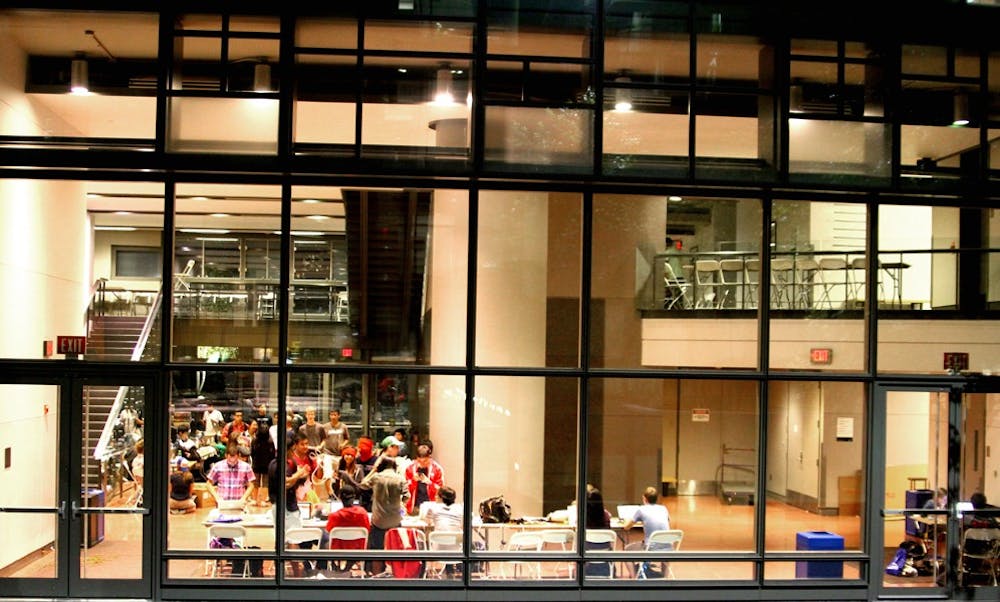
8:30 p.m., Friday — The hack just started. Though just off a flight from Switzerland, the team from ETH Zurich had already arrived at their desks in the Engineering Quad early.
“We are still in jet lag,” said Jorim Jaggi, student at ETH and a member of the team.
Having won second place at January’s hackathon with their Android app Virtual Perspective – using a phone to capture an object and view it in 3D — this time they plan on picking up something more challenging.
The new Android app they are building, called Weighly, will weigh material in a container by using a phone to capture it and use advanced computer vision algorithm to calculate the volume and weight. It is designed to function as a mobile kitchen scale.
Check out a video of the app at this link
“People usually don’t bring a scale with them,” said Selim Cinek, another team member. “So we thought of the idea — what if people just want to pull out their phone and weigh how much is in their bowl?”
“It definitely gave us more pressure,” Jaggi said when asked about last year’s placing. “We are doing a lot of research to make sure it works.”
11:00 p.m., Friday — “It’s 5:00 a.m. in Switzerland right now.” Selim Cinek held up his tablet. However, it wasn’t a good time for him to go to sleep, because the team had run into a problem.
“We wanted to construct a 3D model of the bowl and the fluid in it on your app by scanning with your camera,” said Jaggi. “In theory it will work, but when coding it into practice, the model doesn’t come through.”
“Busy,” Christian Reiter said when asked for one word to describe their current feeling as he lay back into his chair.
2:00 p.m., Saturday — Adrian Roos and Selim Cinek tested their algorithm by scanning a bowl with liquid using their tablet. On the screen, the camera accurately captured the edge of the liquid in the bowl with green circles, and sent data into the backstage.
“When the 3D model didn’t work, we came up with the idea of a computational method around 6 or 7 in the morning – just calculating the volume without actually building a model,” said Jaggi. “It sounds very similar but it’s a different approach.”
7:00 p.m., Saturday — The team was running another test with the algorithm, but this time they put rice in the bowl.
“We are almost done. The basic structure is already set up. We just have a lot of polishing to do,” said Jaggi. “We want to make sure it works for different cases – fluid, rice, sugar … anything.”
They worked to adjust the app to different type of bowls.
“We brought all these different bowls here for testing,” he said, and pointed to several colorful bowls on the table. “They each have different shapes and marks — in this way, we can see whether the app can capture the edge of the fluid regardless of [the bowl’s] color, shape or pattern.”
12:00 a.m., Sunday — The team finished the app and prepared for their demo video. In the past, each team needed to do two demos on Sunday — one to the judges and one to the companies. This year, everyone needs to submit a video for the judges’ decision.
“I would prefer live demo,” said Cinek. “We now need to spend another two hours making the video, while they could have been used for coding.”
The team thinks that their app is more a theoretical exploration than a practical product to put into the market.
“This is more of a proof of concept,” said Jaggi. “We want to prove that this concept of measuring weight using a phone camera and computer vision algorithm [is] applicable. Once this concept works, there are a lot more to build on in the future.”
12:00 p.m., Sunday — The team presented its app during the company demo in the Palestra, explaining its nuances and showing off its features.
Related: Tweeting the PennApps Hackathon
The group enjoyed the weekend of coding, and considered it more important to have been able to build such an app to prove their concept than to have won top prizes. This year, the team made it into the finals but not the top three.
“What we tried to do this time is more technically challenging — we ran into a lot of difficulty in the middle, while last time it went very smoothly,” said Cinek. “This was an experiment, but we are very glad that it works.”
The Daily Pennsylvanian is an independent, student-run newspaper. Please consider making a donation to support the coverage that shapes the University. Your generosity ensures a future of strong journalism at Penn.
DonatePlease note All comments are eligible for publication in The Daily Pennsylvanian.





